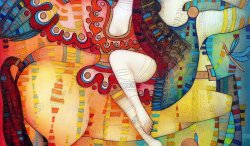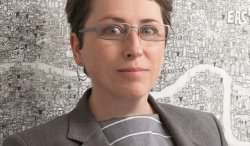- Jobs
- Open Calls
- Events
- Learn
- More
- SUBMIT
Interview with Ana Kim

Ana Kim
Ana Kim
Tell us a little about your artistic background.
I am a Korean-born artist. I am now based in two different cities - Seoul, South Korea, and Chicago, Illinois. After receiving BFA from the University of Illinois at Urbana Champaign, I have done many group exhibitions both in Korea and the United States, some solo exhibitions, art fairs, and even a virtual exhibition due to COVID-19. I was selected for several projects hosted by the Korean government and the City of Chicago. I am now furthering my markets to Europe and other countries in Asia.
Why do you paint animals? What does that mean to you?
I first started using animals as a subject for my paintings to convey their symbolic and cultural meanings. As we are in a multicultural society, I was able to receive comments from my audience which differ from another. For example, one audience saw my tiger painting and took it as a powerful passionate feeling while another translated it as a warm loving piece. Everyone sees animals in my paintings and interprets them differently. This fascinates me and inspires me. I enjoyed one animal having different images by one’s imagination, background, culture, etc. Also, as a nature-lover, I am into expressing the message about how nature is priceless and that we all should be taking care of it. I hope my audience can connect nature and animals’ habitats, and become aware of its value to us.
How do you paint animals and nature?
First, I love to travel. I collect photos from everywhere. Most of the backgrounds are combined from my travel images and my imagination. To paint animals, I collect photos from different angles or sometimes use video. Then I merge pieces to get the gesture I want.
What do you want to make? What makes your art different from others?
Re-arranging animals and nature in seemingly odd, I intentionally create a different atmosphere meaning two subjects do not match if thinking inside the box. I want to go beyond the notions of life, nature, and everything by breaking their habitats. I wish to talk about diversity and how seemingly odd elements can fit and co-operate with each other. I am also trying to open up my own and my audience’s perspectives. Creating new order, is my way of communicating through art and challenging myself against norms. What I want to make from my works is a new distinctive genre of painting. What I want to say is about the variety, diversity as well as the mind, thoughts beyond the norm.
How/why did you decide to paint?
Many artists these days adopted new technologies such as using photography, computer design, and even sound to create their own art. I respect all sorts of art. But I also believe the tradition of making fine art using canvas and brush is still unique. I am going to paint on a flat-surfaced canvas with actual paint, making it a one-and-only, non-duplicable, painting. Yet, I am going to create art that even on a flat canvas, contains deep meaning which everyone can interpret differently.
Moreover, I am also challenging myself by re-producing my paintings into digital technology, such as transferring my original paintings into NFT. But I am very new to this and I am still learning about it.
Now tell us about your series.
As mentioned in the statement, I am mainly working on two series: direct depiction and implicit depiction. Direct depiction is with the actual background, while implicit depiction has vague background such as solid colors. I sometimes want to show the background more clearly, and sometimes I want to open up my audiences to imagine their own backgrounds.
Can you describe what an average working day for you is like? Do you work on many creations at once or one at a time?
As a full-time artist, I can say I am with my works all day. I always try to paint during daylight and work on others such as sketches, document works, and many other things related to my work presentation in the evening. But, I guess I am more a night owl type of person, so more work is done at night. I do work on many creations at once, even different series at the same time. I feel like working on different series at the same time lets me focus with greater inspiration.
How have you developed your career? How do you seek out opportunities?
By participating in art fairs from different countries - England, South Korea, Japan, United States, France, and Netherlands - I am trying to further my market. Also, by being represented by galleries / online platforms from different countries - South Korea, United States, and France - I am introducing my works around the world. Gathering feedbacks around the world, from people with different culture, it surely inspires me.
Not only with the art fairs and art exhibitions, but I have also participated in events such as live performances and art rental projects organized by the government.
Furthermore, I have worked as a curator at an art gallery which taught me about the art market and the perspectives of art galleries and collectors. I believe that understanding the systems and relationships of the art market is important to develop myself as a better artist.
To seek out opportunities, I am trying to update myself to all available online platforms and it sometimes brings me opportunities to be featured.
How do you price your work?
The pricing of my works depends on the time I spent plus materials. Usually, the price can be impacted if a specific artwork was featured on an article, awarded with a prize, or presented as a main image from the show.
How does your work comment on current social or political or environmental issues?
This question may be related to my goal. As mentioned earlier, I am carrying a message about nature, species of animals, and their relationship. I paint different animals from different regions, and some people might be unfamiliar with them. Sometimes, my audiences do not differ from jaguars to cheetahs. By giving names of species on the title, I want my audiences to think about them co-existing on the same earth, at the same time.
I break usual habitats in my painting, by means, breaking the perceived norm of the habitat related to a specific animal. I am conveying a message suggesting my audiences imagine that some of the animals’ habitats are now taken by humans. So, who is breaking whose habitat, really? Yet, some people neglect to believe animals’ extinction has little thing to do with habitat loss. Working on my own genre, I sincerely wish my audiences to understand my message, and to further their imagination.
Interview By:
several other organizations, attached text was made for the book by combining interviews into one text.
|
CARNE GRIFFITHS
Fine Artist |
ALBENA VATCHEVA
Fine Artist |
Nicole Chen
Art Administrator and Writer |
JANE HAY
Art Education |









